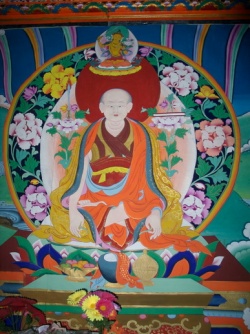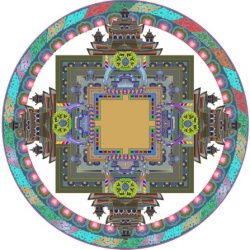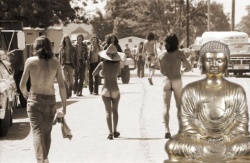Gandavyuha Sutra
- See also :
- See also :
Gandavyuha Sutra (Skt. Gaṇḍavyūhasūtra; Tib. སྡོང་པོ་བཀོད་པ་, Wyl. mdo sdong po bkod pa)
Mahayana Sutra that forms the climax of a larger text, the Avataṃsaka Sūtra. The Avataṃsaka Sūtra was most likely composed in Sanskrit in the 4th century and was first translated into Chinese by the monk Bodhibhadra in the second decade of the 5th century. The Avataṃsaka describes the universe as it is seen and experienced by enlightened buddhas and bodhisattvas, as well as the various stages of a bodhisattva’s progression on the path to enlightenment. In addition to its important position within the Avataṃsaka, scenes from the Gandavyūha, along with ones from other Buddhist texts such as the Divyāvadāna and Lalitavistara, can be found among the bas reliefs of the great Buddhist monument in Java, Borobudur.
In the Gandavyūha, a young pilgrim named Sudhana commences a search for supreme enlightenment that takes him on a journey to see more than fifty teachers—people from all walks of life—and even leads him to an intimate, but nonetheless enlightening, encounter with a prostitute named Vasumitrā, who is also a wise bodhisattva. Sudhana experiences a magnificent cosmological vision, the perspective of enlightened buddhas known as dharmadhātu. Finally, Sudhana attains a vision of the bodhisattva Samantabhadra and realizes that his own nature, and those of Samantabhadra, all buddhas, and all other existences in the cosmos are, in fact, one and infinitely interpenetrate one another.
The last chapter of the Avatamsaka circulates as a separate and important text known as the Gaṇḍavyūha Sutra (lit. 'flower-array' or 'bouquet'; 入法界品 ‘Entering the Dharma Realm’). Considered the "climax" of the larger text, this section details the pilgrimage of the youth Sudhana to various lands at the behest of the bodhisattva Mañjuśrī.
In his quest for enlightenment, Sudhana would converse with a diverse array of 52 kalyāṇa-mittatā (wise advisors), 20 of whom are female, including an enlightened prostitute named Vasumitrā, Shakyamuni's wife and his mother, a queen, a princess and several goddesses. Male sages include a slave, a child, a physician, a ship's captain. The antepenultimate master of Sudhana's pilgrimage is Maitreya. It is here that Sudhana encounters the Tower of Maitreya, which — along with Indra's net – is a most startling metaphor for the infinite:
- In the middle of the great tower... he saw the billion-world universe... and everywhere there was Sudhana at his feet... Thus Sudhana saw Maitreya's practices of... transcendence over countless eons (kalpa), from each of the squares of the check board wall... In the same way Sudhana... saw the whole supernal manifestation, was perfectly aware of it, understood it, contemplated it, used it as a means, beheld it, and saw himself there.
The penultimate master that Sudhana visits is the Mañjuśrī Bodhisattva, the bodhisattva of great wisdom. Thus, one of the grandest of pilgrimages approaches its conclusion by revisiting where it began. The Gaṇḍavyūha suggests that with a subtle shift of perspective we may come to see that the enlightenment that the pilgrim so fervently sought was not only with him at every stage of his journey, but before it began as well—that enlightenment is not something to be gained, but "something" the pilgrim never departed from.
The final master that Sudhana visits is Samantabhadra Bodhisattva, who teaches him that wisdom only exists for the sake of putting it into practice; that it is only good insofar as it benefits all living beings. Samantabhadra concludes with a prayer of aspiration to Buddhahood, which is recited by those who practice according to Atiśa's Bodhipathapradīpa, the foundation of the Tibetan Lamrim textual traditions.
Despite its being at the end of the Avataṃsaka, the Gaṇḍavyūha — and the Ten Stages — is generally believed to be the oldest components written.
Famous Quote:
- རིགས་ཀྱི་བུ་ཁྱོད་ཀྱིས་བདག་ཉིད་ལ་ནད་པའི་འདུ་ཤེས་བསྐྱེད་པར་བྱའོ། །
- ཆོས་ལ་སྨན་གྱི་འདུ་ཤེས་བསྐྱེད་པར་བྱའོ། །
- དགེ་བའི་བཤེས་གཉེན་ལ་སྨན་པ་མཁས་པའི་འདུ་ཤེས་བསྐྱེད་པར་བྱའོ། །
- ནན་ཏན་ཉམས་སུ་ལེན་པ་ནི་ནད་ཉེ་བར་འཚོ་བའི་འདུ་ཤེས་བསྐྱེད་པར་བྱའོ། །
- Noble one, think of yourself as someone who is sick,
- Of the Dharma as the remedy,
- Of your spiritual teacher as a skilful doctor,
- And of diligent practice as the way to recovery.
The Supreme Array Scripture (Gandavyuha-sutra)
This lens is dedicated to promoting information about the Mahayana Buddhist scripture known as the Gandavyuha-sutra. The Gandavyuha is one of the most important Mahayana Buddhist Scriptures. In it is told the story of Sudhana, a young merchant-banker's son, who goes on a quest for supreme enlightenment in ancient India during the time of the Buddha. While on his quest, Sudhana visits 53 different spiritual guides who teach him about the bodhisattva's path to enlightenment and reveal an awesome vision of an interpenetrating and inter-reflecting universe wherein all time and space exists as a totality.
The Story of Sudhana
The Gandavyuha-sutra was composed somewhere in the Indian sub-continent probably during the first few centuries of the Common Era. As the 'final book' of a much larger text, the Avatamsaka-sutra ('Flower Ornament Scripture'), it was translated into Chinese for the first time in the early fifth century CE, and became one of the foundational texts of the Chinese philosophical school called Hua-yen. The Gandavyuha was translated into Tibetan in the early ninth century, and an inscriptional text of it accompanied by paintings can still be found today on the temple walls of the monastic complex at Tabo dating to the tenth century. In the late eighth or early ninth century, scenes depicting the complete narrative of the Gandavyuha were carved into the gallery walls of Barabudur in Java, the largest Buddhist monument ever built. Thus the impact of the Gandavyuha's narrative and worldview upon Asian religious art and thought is undeniable.
The Gandavyuha-sutra is the story of a young man's quest for enlightenment in ancient India during the time of the Buddha. Like the Buddha, this young man named Sudhana ('Good Wealth'), the son of a merchant-banker, leaves home in search of spiritual counsel. But Sudhana does not renounce the world and take up ascetic practices; rather on the advice of the bodhisattva Manjusri he sets out to visit 'good friends' (kalyanamitra) in order to learn how to carry out the course of conduct of a bodhisattva. After travelling far and wide across India visiting numerous good friends of various occupations (the Gandavyuha narrates fifty-two of these encounters), Sudhana has his final visionary experience of and merges with the supreme bodhisattva Samantabhadra. The sutra concludes with Samantabhadra reciting the 62 verses known as the 'The Vow to following the Good Course' (Bhadracaripranidhanam) wherein he proclaims the highest aim of a bodhisattva to save all beings, worship all buddhas and be reborn in Amitabha Buddha's Land of Bliss.
Source
Wikipedia:Gandavyuha Sutra
wisdomlib.org
britannica.com
lotuschef.blogspot.com.au



